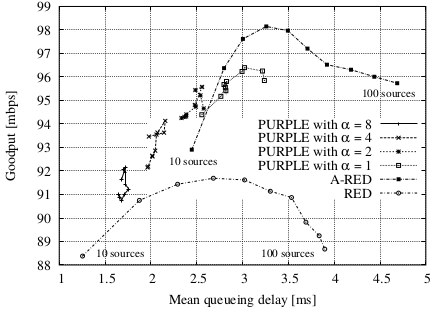
Links
Abstract
Active Queue Management (AQM) is an attempt to find a delicate balance between two antagonistic Internet queuing requirements: First, buffer space should be maximized to accommodate the possibly huge transient bursts; second, buffer occupation should be minimum so as not to introduce unnecessary end-to-end delays. Traditional AQM mechanisms have been built on heuristics to achieve this balance, and have mostly done so quite well, but often require manual tuning or have resulted in slow convergence. In contrast, the PURPLE approach predicts the impact of its own actions on the behavior of reactive protocols and thus on the short-term future traffic without keeping per-flow state. PURPLE allows much faster convergence of the main AQM parameters, at least towards a local optimum, thereby smoothing and minimizing both congestion feedback and queue occupancy. To improve the quality of the prediction, we also passively monitor (using lightweight operations) information pertaining to the amount of congestion elsewhere in the network, for example, as seen by flows traversing this router.
Notes
We would like to emphasize the fact that the RED/ARED measurements in the paper were done against the ECN-enabled version of these mechanisms. Even though they significantly outperformed the ECN-unaware RED/ARED results (not shown in the paper), there still were substantial packet drops.
Our paper on Closed-Loop Congestion Control for Mixed Responsive and Non-Responsive Traffic also uses control engineering for AQM. The goal there is to remove the negative impact non-responsive traffic has on well-behaving traffic.
BibTeX (Download)
@inproceedings{Pletka2003PURPLE,
title = {PURPLE: Predictive Active Queue Management Utilizing Congestion Information},
author = {Roman Pletka and Marcel Waldvogel and Soenke Mannal},
url = {https://netfuture.ch/wp-content/uploads/2003/pletka03purple.pdf},
year = {2003},
date = {2003-10-01},
urldate = {1000-01-01},
booktitle = {Proceedings of IEEE LCN 2003},
pages = {21--30},
abstract = {Active Queue Management (AQM) is an attempt to find a delicate balance between two antagonistic Internet queuing requirements: First, buffer space should be maximized to accommodate the possibly huge transient bursts; second, buffer occupation should be minimum so as not to introduce unnecessary end-to-end delays. Traditional AQM mechanisms have been built on heuristics to achieve this balance, and have mostly done so quite well, but often require manual tuning or have resulted in slow convergence. In contrast, the PURPLE approach predicts the impact of its own actions on the behavior of reactive protocols and thus on the short-term future traffic without keeping per-flow state. PURPLE allows much faster convergence of the main AQM parameters, at least towards a local optimum, thereby smoothing and minimizing both congestion feedback and queue occupancy. To improve the quality of the prediction, we also passively monitor (using lightweight operations) information pertaining to the amount of congestion elsewhere in the network, for example, as seen by flows traversing this router.},
keywords = {},
pubstate = {published},
tppubtype = {inproceedings}
}



